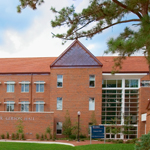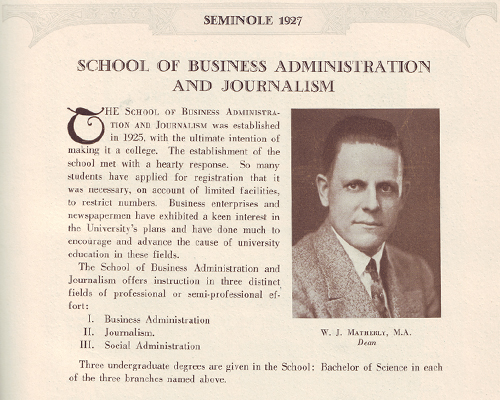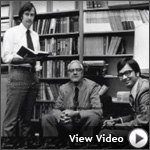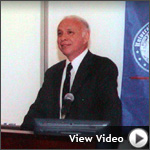History of Accounting at UF

In Brief:
Gary R. Gerson Hall, Dedicated 2004
- 1923: First Accounting Course Offered
- 1924: First Accounting Paper by UF Faculty Published
- 1928: Accounting Appears as Separate Area of Specialization
- 1938: UF Upsilon Chapter of Beta Alpha Psi Approved
- 1947: Department of Accounting Officially Formed
- 1974: Steering Committee Organized
- 1975: Plan to Establish of School of Accounting
- 1977: Experimental School of Accounting is Approved
- 1983: The School of Accounting at UF is made Permanent
- 1985: Frederick Fisher endows the School of Accounting
- 2004: Gerson Hall, housing Fisher School of Accounting, is dedicated
Accounting, Then...
Accounting at the University of Florida traces its roots back to 1923 when the first accounting course was offered. The course, ECONOMICS XI—Elementary Accounting, was taught by Orton Wells Boyd. Boyd earned his undergraduate and master's degrees from The Ohio State University. At 28, he was appointed by President Murphree as the first professor of accounting and business training at the University of Florida.
Professor Boyd was also the first UF faculty to publish an accounting paper. “Valuation for Profits Determination” was published in June, 1924 by The American Association of University Instructors (in its publication of Accounting Papers and Proceedings, Vol. VIII, No. 1). This collection of papers, gathered from its annual meetings, was the forerunner of The Accounting Review which, to this day, is one of the most prestigious scholarly accounting journals. Professor Boyd is also distinguished as the first University of Florida faculty to have a paper published in The Accounting Review. His paper titled “Accounting Problems of the Florida Real Estate Boom” appeared in its first volume in 1926 (Vol. I, No.3, pp. 64-73).
From the few first course offerings in the early 1920s, the demand for more from students and the business community grew. To satisfy the demand, the School of Business Administration and Journalism formed within the College of Arts and Sciences. Walter Jeffries Matherly was appointed as its first Director in 1926. Within a year, the fledgling School was transformed into the College of Commerce and Journalism and Matherly was appointed its dean.
Though still housed with the Arts and Sciences faculty in Language Hall, (Anderson Hall as its known today) the new college rapidly established its own distinct identity. As described in the 1928 University Record, the degree in Business Administration was a mix of “cultural and professional courses.” By 1933 the transformation was completed when Sociology returned to the College of Arts and Sciences and the College of Commerce and Journalism was renamed the College of Business Administration. During these transformative years, accounting for the first time appears in the 1928 University Record as separate area of “professional specialization,” but the accounting faculty consisted of a single faculty member, H.W. Gray.
By 1938 the demand for accounting continued to grow and the faculty size grew to four. Students petitioned the governing body of Beta Alpha Psi to establish a chapter on campus. Founded in 1919, Beta Alpha Psi is an honorary organization for accounting students and boasts 300 chapters. Its primary objective is to encourage scholastic and professional excellence in accounting and to instill a sense of ethical, social, and public responsibility. The University of Florida Upsilon chapter of Beta Alpha Psi was approved in 1938 and it became only the 20th chapter formed in the nation. The inaugural class included 28 members.
The emergence of World War II brought a significant decline in enrollment across the University. By the war's end, the decline, combined with large number of young professionals who had been called to military service, created a severe shortage of trained business professionals. A memo by accounting professor David Beights to Dean Matherly on March 29, 1945 predicts an explosive demand for accountants in the coming years. He wrote: “Indications are such that an increased enrollment in accounting may be expected after the war. This is likely because of the shortage of accountants brought about by the discontinuance of study during the war, and the increased demand for accountants as a result of increased taxes, increased governmental control and regulation, and other normal developments in both business and in government.” “A second aspect to the problem which is significant is that the training of the accountant must be broader and more advanced, technically, than it was 5 years ago. The field of operations has broadened as well as business expects a student to have more than ‘first’ courses in the various fields, such as auditing, income tax, cost accounting, and governmental accounting.”
Professor Beights was an early proponent of rapidly increasing the number of accounting faculty and organizing as a department in order to meet the predicted demand. Though departmental approval did not officially occur until 1947, the growing unit functioned as a de facto department with Beights as its acting head until his departure in 1946.
In 1947 the department of accounting was officially formed with newly hired Professor James Lanham appointed as first Head of the department. The department boasted 14 faculty and 255 upper-division students. The new department was relocated to one of the many temporary wooden structures built to handle the massive influx of students Beights had predicted in 1945.
Temporary Building A was located near the south-east corner of the Student Services building (better known as the Hub today). The small wood building had four, 50 seat classrooms which were used to teach all 56 sections of accounting courses offered. The building had 5 small offices that had to be shared by the 16 person faculty and staff. Conditions were deplorable. The building lacked air conditioning, window shades, or even fans. The heat was oppressive and the noise resulting from the thin walls was ever present. Class seating was limited to traditional tablet-armed desks strapped together with boards to keep them aligned in rows. Almost immediately Lanham sought improved facilities for the accounting department, but progress was slow and relief would not come until 1954 when Matherly Hall was constructed and the accounting faculty rejoined their colleagues from the College of Business Administration.
Stability reined for the accounting department for two decades until 1974 when John Simmons was appointed Chair of the accounting program. One of his first decisions was to organize an external Steering Committee to assist in obtaining enrichment funding for the accounting program. Shortly thereafter he charged this committee with the task of exploring the possibility of reorganizing the department as a School of Accounting. With the support of the accounting faculty and the Steering Committee, John Simmons approached the dean about establishing a School of Accounting. Dean Lanzillotti was skeptical but supportive; to ensure the school would be financially viable, he a required a minimum $1,000,000 in outside funding be raised before proceeding. In only two short years the funding requirement was met through a grant of $40,000 from the State Board of Accountancy and by subsequent donor contributions. In 1977, College of Business faculty, the UF Senate, and the Board of Regents approved the establishment of a new administrative unit entitled “School of Accounting” as an experimental model for a six year period. The entire faculty and administration relocated from Matherly Hall to Bryan Hall to chart its new path. John Simmons was appointed the first Director of the School of Accounting.
In 1982, UF representatives approached 1959 alumnus Fred Fisher for a $3 million donation. Asked at the time to assist with a business deal up north, Fred agreed to donate any profits that came his way from the deal. Fred proved to be instrumental in moving the accounting program forward, and in 1983 the UF Faculty Senate voted to make the School of Accounting permanent. In 1985, much to even Fred's surprise, the business deal he committed to donate to UF closed and netted him close to $8 million, a number far exceeding his expectations. True to his word, Fred donated all of the money, breaking it up between UF and another of his passions, The Center Foundation, and the University of Florida School of Accounting was renamed in his honor in 1985.
Documents
-
 Board Grants 40,000 to UF for Experimental School of Accounting
Board Grants 40,000 to UF for Experimental School of Accounting
-
 Initial Contributions and Pledges
Initial Contributions and Pledges
-
 Faculty 1976-77
Faculty 1976-77
-
 1967-68 Courses Catalog
1967-68 Courses Catalog
-
 1949 Seminole Yearbook, Typical Accounting Problem
1949 Seminole Yearbook, Typical Accounting Problem
-
 University Record 1947-48
University Record 1947-48
-
 School of Accounting Brochure, 1977
School of Accounting Brochure, 1977
-
 1927 Seminole Yearbook
1927 Seminole Yearbook
Accounting, Today...
Today, Gerson Hall houses the Fisher School of Accounting administrative offices and its faculty. The 36,000 square foot, 9.3 million dollar structure was dedicated on April 10, 2004.
The quality of the Fisher School of Accounting students is exceptional. Eighty-five percent of University of Florida students score above the national mean on standard entrance exams taken by college-bound students, and the students who subsequently enter the Fisher School are particularly outstanding. On average, students admitted to the graduate accounting program score well above the 70th percentile on the Graduate Management Aptitude Test (GMAT).
The School's faculty members have earned Ph.D. degrees from the nation's leading universities. The faculty is committed to excellence in teaching, research, and service. In addition to publishing the School's own research journal, the faculty actively contribute to the accounting profession by maintaining editorial positions for major accounting journals, participating in professional organizations at the national and state levels, and providing services to major corporations and public accounting firms.
The Fisher School is committed to being the very best accounting program in the nation. Each generation of graduates contributes to the School's success. Alumni become leaders in the business world and academia, their accomplishments attract attention to current students, and generous alumni and friends provide the financial support that allows Fisher School of Accounting to offer a world-class environment for learning and scholarship. This environment in turn attracts outstanding faculty members and students so that the School may build on the foundations created by those who have worked so hard in the past.


